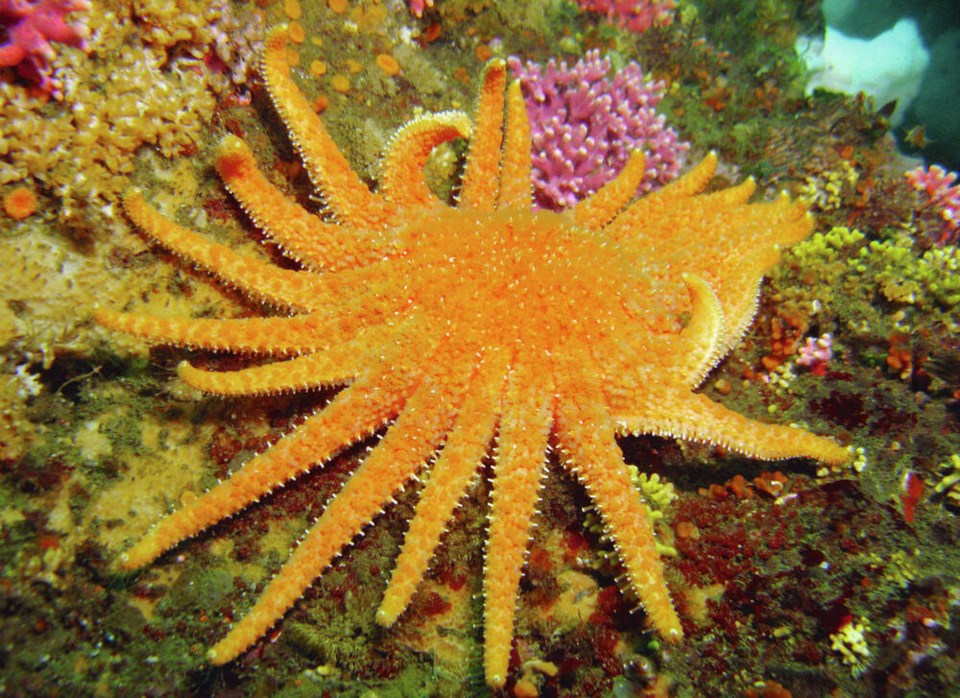Warmer summers, heat domes and marine heat waves are transforming sa¹úŒÊŽ«Ãœ’s coastal waters, and the consequences may well be far-reaching and long-lasting, a series of recent studies suggest.
Over the past decade, 90 per cent of sunflower sea stars have disappeared from sa¹úŒÊŽ«Ãœ waters. The near-extinction of the colourful, many-armed seafloor-dwelling predator has removed checks on the region’s sea urchin populations, which inhabit rocky reefs and voraciously eat kelp.
Without natural predators, sea urchins quickly devour entire kelp forests, creating seafloor deserts known as “urchin barrens.”
According to a study released in October by Vancouver-based conservation organization Ocean Wise, the decimation of sunflower sea stars has already resulted in barren underwater landscapes in places such as Howe Sound.
Kelp forests are important breeding grounds and nurseries for many fish and invertebrate species. They also sequester carbon and buffer climate change’s effects on ocean acidity.
The sea stars’ decline is due in part to an outbreak of sea star wasting syndrome. The disease starts with small lesions, but, within days, the sea star dissolves into goo.
Recent warming temperatures have contributed to the illness’s spread. According to a U.S. study released last year, sea star wasting syndrome may be caused by a microbe bloom around each affected sea star. Some bacteria that live on sea stars’ skin thrive in warm water, reproducing like mad and using up the oxygen in the water immediately around the sea star. Without oxygen, the sea star suffocates and starts to dissolve.
Pockets of sunflower sea stars remain in deep-water fjords. It’s not yet known if these populations still persist because the disease hasn’t yet spread there or if the cooler water prevents the bacterial blooms.
Researchers say programs to aggressively control sea urchins by harvesting them for food, to replant kelp beds, and to captive-breed sea stars are needed, as is more research into other factors underlying the illness.
But sea star wasting syndrome is not the only climate-triggered marine disease hammering our coasts. Research shows that large swaths of seagrass in the region’s intertidal meadows are impacted by another lesion-causing disease.
“Not only are we seeing more seagrass wasting disease outbreaks, we’re seeing a severe impact within the vital nutrient stores of these plants in the roots — so they become compromised late in the growing season, setting them up for a harder winter,” said Olivia Graham, of Cornell University, one of the lead authors of the study published in November in the journal Frontiers in Marine Science.
The study showed that lesioned plants had lower starch reserves in their roots and grew more slowly. With less starch in the roots, the meadows themselves become less resilient.
Eelgrass, one of the most common species of seagrass, normally thrives in the sheltered, shallow, salty and brackish estuaries, bays and inlets of the Salish Sea. Its meadows can be found along the Gorge, in Portage Inlet, in Oak Bay, as well as in other sheltered, shallow waters along the shorelines of the south island and the Gulf and San Juan islands.
Seagrasses protect shorelines by stabilizing sediment. They improve water quality by trapping fine particles and preventing algal blooms. And they sequester carbon. In sa¹úŒÊŽ«Ãœ, seagrass meadows provide food for marine mammals and migratory water and shorebirds and are critical habitat for juvenile endangered salmon and rockfish and at-risk herring, as well as clams, mussels and oysters. An estimated 80 per cent of commercial fish and shellfish species depend on eelgrass habitat at some point in their lifecycles.
Seagrass wasting disease has been present here for decades, but warming waters promote the marine slime mould that causes the disease. In a related study, researchers showed the disease’s prevalence in eelgrass meadows in the San Juan Islands increased from five to 70 per cent in 2013 to 60 to 90 per cent in 2017. Between 2013 and 2015 — when the region was hammered by the longest marine heatwave on record — the density of new eelgrass shoots declined by more than half and didn’t recover.
The increase in disease prevalence correlated with warmer water temperatures for the month before sampling, mirroring laboratory results.
With temperatures rising, marine diseases are spreading, and our eelgrass meadows and kelp forests are declining. How will the species, coastlines and communities that depend on those ecosystems weather the change?



